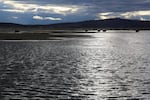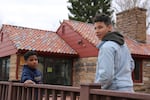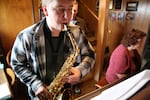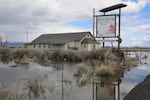Composer Chris Thomas was commissioned by the Central Oregon Symphony Association to celebrate natural wonders and communities in the Harney Basin, which has supported human imagination for more than 10,000 years. The resulting symphony conjures the history of the Harney Basin in five movements.
Listen to the symphony by hitting the play button below.

Composer Chris Thomas in his Central Oregon Community College studio in Bend, Ore., on April 8, 2019.
Emily Cureton / OPB
Chris Thomas was born in Pendleton, and now splits his time between Bend and Los Angeles. This was his first symphony commission.
THOMAS: The message to the piece is to find healing in common ground with people around you. That's ultimately what I wanted from this.
My very first experience out there was stepping out of the car in the middle of the basin and feeling the sense of openness and sacredness. I thought, "That right there has to mean something musically."

Cows graze a flood-irrigated field near Burns, Ore., on April 13, 2019.
Emily Cureton / OPB
The symphony begins with the dawning of time, the formation of the Malheur Basin and the first signs of wildlife to show up. Movement 2 [is about] the next momentous event: the first people to show up. Movement 3 is more of a summary of the darker chapters in history, because long before there were anti-government protests, the Paiute people were once forcibly removed from the land. And Movement 4, we needed something about the birds, which are probably the most famous feature of Malheur these days. I think my favorite was the long-billed curlew. It has a special set of calls that happen to be in the key of D harmonic minor. When I wrote the movement, I didn’t compose any new melodies. I only took bits and pieces that the curlew sing. They were so useful I didn’t need to compose anything else.
Then, the last movement just began taking the shape of this bright brassy fanfare and I realized, "Oh! That's what I'm trying to say!" Be excited about these places. Movement 5 doesn't really need to be about anything in particular, it's just looking ahead and celebrating a new and exciting future for places like Malheur.

Jailyn Price, left, and Niyati Graf recently moved to Burns and visited the Malheur National Wildlife Refuge for the first time on April 16, 2019.
Emily Cureton / OPB
Diane Teeman is director of the Culture and Heritage Department for the Burns Paiute Tribe.
TEEMAN: There were thousands of people that lived here for thousands and thousands and thousands of years, and we have a responsibility to all of the lands that we call home. With music, individuals typically would have songs that were given to them or that they created to give to the landscape, honor the landscape, and make [it] feel good and be happy with your presence there.
The 2016 occupation was devastating emotionally, for me personally, and also for a good many of our tribal community members, because of the importance of the location. Historically [we] have been unable to have a great deal of access or control over the management of that area, even though it is at the heart of our culture.
I see this [symphony] as an attempt ... to help heal the land through music, using music to try and compensate for the damage that was done.

Susan Doverspike stops the truck to photograph birds near her family's cattle ranch near Burns.
Emily Cureton / OPB
Susan Doverspike is a fourth-generation rancher in Harney County.
DOVERSPIKE: We are grass managers. If we don't take care of the land, it won't be here for the next generation. And because it is hayed every year, [the grass] is tender, new and green, and the birds love it. We live three-quarters of a mile from the paved road. And when I would take the kids to meet the bus at the end of the lane, there would be about 15 kinds of birds along the way, and each week those varieties would change.
If we want to go see a concert of a symphony, we can get in the car and go. It’s five hours one way most of the time. But, this [land] is a concert, and this [land] is a symphony, and the people in Harney County are salt of the earth.

Christian Boyd plays the saxophone, accompanied by music teacher Debby Peckham in Burns, Ore., on April 14, 2019.
Emily Cureton / OPB
Christian Boyd is a senior at Burns High School. He plans to attend the University of Oregon in the fall. There are about 50 kids in his graduating class.
BOYD: When you live with people and you know them, like, if you go to the store and [say], "Wow. Hey, I know that person," it creates a community that is not only strong in the first place, but every time something bad happens can get even stronger from that. Damage is inevitable, but because of where we live, growth and healing [are] also inevitable.
I'm really excited because I'm gonna get to play music at my dream school. I mean you couldn't ask for something better than that. I'll definitely miss my family and the community and my friends but I'm ready for the next step. I'm going to go where the music takes me.

A view from the road between Burns and the Malheur National Wildlife Refuge on April 14, 2019.
Emily Cureton / OPB
The Malheur symphony world premiere is May 5 at Burns High School, with performances in Bend May 18, 19 and 20. This transcript has been edited for brevity and clarity.

